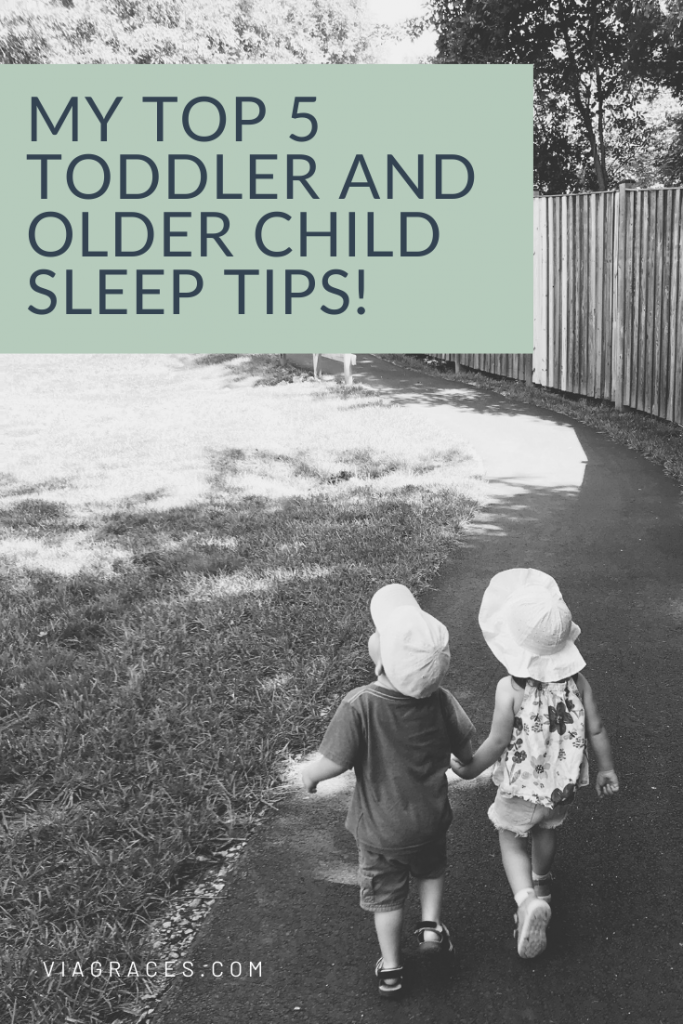Whether your child has never been a great sleeper, or used to be a great sleeper but things have since gone haywire, sleep is absolutely still possible!
So in this post I am giving you my top five tips for helping your toddler or older child establish healthy sleep skills, including:
- Establish consistent routines
- Set and hold consistent expectations (don’t miss the freebie!)
- Implement the use of a toddler clock
- Watch out for screens too close to bedtime
- Set an age-appropriate bedtime

Establish Consistent Routines
Having a predictable bedtime routine is key to great sleep! It not only gives your child time to transition between day time fun to night time rest, but it prepares his body to sleep for the night. An example of a good bedtime routine for an older child is:
- Bath/shower
- Pajamas and brush teeth
- [For kids who struggle with bedtime fears or anxieties, this is a good time to recite some affirmations or a Bible verse, and/or do some breathing exercises that help them calm.]
- Read two books/one chapter of a book
- Small back rub or “story massage” (if your child would enjoy it)
With older kids, it’s especially important that they recognize that parents are in charge of the bedtime routine.
I am all for giving kids choice – which pajamas they want to wear, which stuffed animal to bring to bed, what two books they want to read, etc. But parents are still in charge of deciding when it’s time for bed, of making sure their child’s bed doesn’t become a zoo of toys, and when reading time is all done, it’s really all done.
As soon as parents start giving in to, “just one more story,” or, “just lay with me tonight,” more excuses and stalling tactics are likely to come and we don’t want bedtime to become a battle of the wills!
If your child’s bedtime routine is a struggle, consider using a visual schedule and pretend play to prepare for the bedtime routine!
Have Consistent Expectations
Bedtime is unfortunately when we, as parents, are exhausted, and all we want is for our kids to go to sleep so we can rest and then go to sleep ourselves, so it’s easy to jump into survival mode and take the easier route (I’ll lay with you until you’re asleep, I’ll sit outside your door, you can just sleep with me, etc.).
Those routes, however, keep us stuck in a rut that’s harder to get out of. So when I work with families of toddlers and school-aged kids, we set some bedtime rules. Those are almost always:
- Lay down in bed
- Be Quiet
- Stay in Bed Until [your clock turns blue, your clock says 7]
[Get those three rules in printable form for FREE right here!]
Not only will these rules teach your child good bedtime behavior, but in order for your child to actually be able to fall asleep, these things need to be happening! And just like any rules you establish at home or your child’s teacher establishes at school, rules are only rules when they’re enforced.
So if you have these bedtime rules in place, be ready to have some sort of rewards and/or consequences for following or not following the rules, and then BE CONSISTENT!
Implement the Use of a Toddler Clock
Night wakings and/or early morning wakings seem to be at the top of the list of frustrations for parents of older children struggling with sleep.
When I work with older kids, I always suggest using a toddler clock, as they are a great way to establish boundaries and rules around bedtime, and they also give some of the responsibility to your child (i.e. “Red means bed.” Or, “If you wake up and notice your clock isn’t blue, it’s still time for sleep.”)
Use Screen Time Carefully
Screens can be a great tool to have a little midday rest, family movie time, or to use as a distraction while parents are trying to get work done, etc. In order to help keep our kids’ sleep best in tact, however, it is best to avoid screen time at least one hour before bedtime, although two hours is ideal.
This is because blue light blocks the release of melatonin, our body’s natural sleepy hormone, which releases in the evening to help us fall asleep. If kids (or adults) go straight from their phones to bed, TV to bed, or a tablet to bed, it often makes it much more difficult to get fall sleep. Screen time right before bed can also cause nightmares for some kids!
Don’t be Afraid of an Early Bedtime
“Just put your child to sleep later and he will sleep later.” This is a piece of advice I have been given and have heard others receive, but in general, it’s just no true!
An ideal bedtime for babies and young kids is between 6:30-8:00 pm (with older school-aged kiddos, I’m willing to stretch to about 8:30 pm). If children go to bed much later than 8:30 pm, we will likely need to wake them in the morning for school, thus not allowing them to get consistent full nights of sleep.
(If your child is over the age of 3 and is still napping, and bedtime is a struggle, it is likely time to drop the nap altogether. But don’t worry, you can replace that nap time with a quiet time so you both still get some rest time during the day!)
Conclusion
As both the mom of a toddler and a sleep consultant who has worked with many toddlers and older kids, I will be the first to tell you, it can be hard! And it takes time for older kids to get into a consistent pattern of falling asleep and staying asleep (these are three week plans rather than two), but it is not impossible and is SO worth it!
If you’re looking for more information about your toddler or older child’s sleep so you can feel confident navigating any changes or bumps in the road that may come up as they get older, checkout Big Kid Sleep from A to Z – a sleep foundations course all about toddlers and older kids ages 18 months-5 years old.
With Grace,
Lauren
